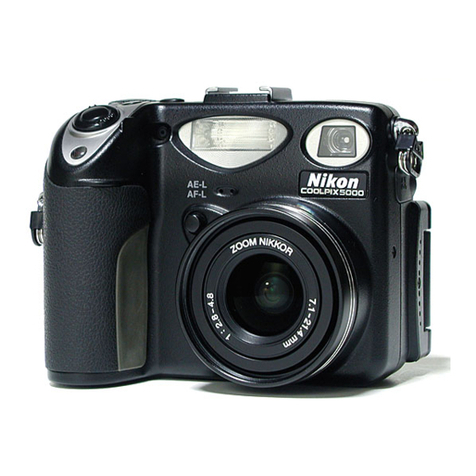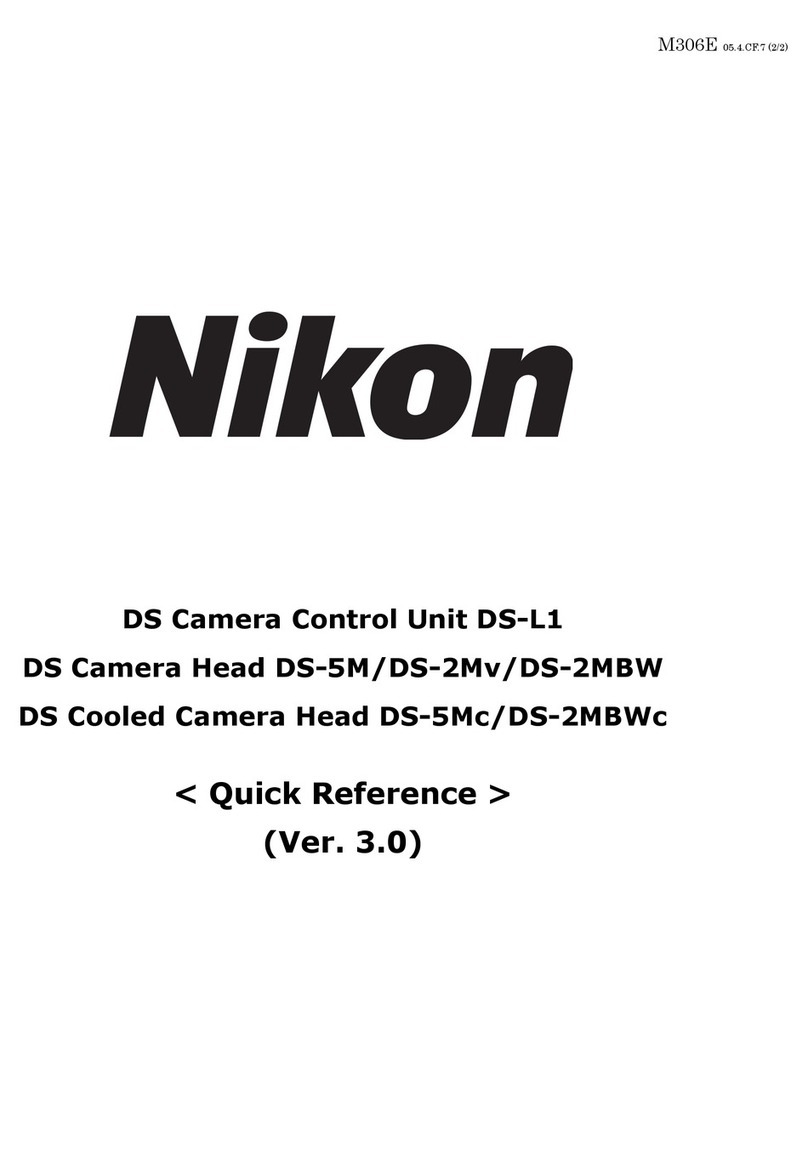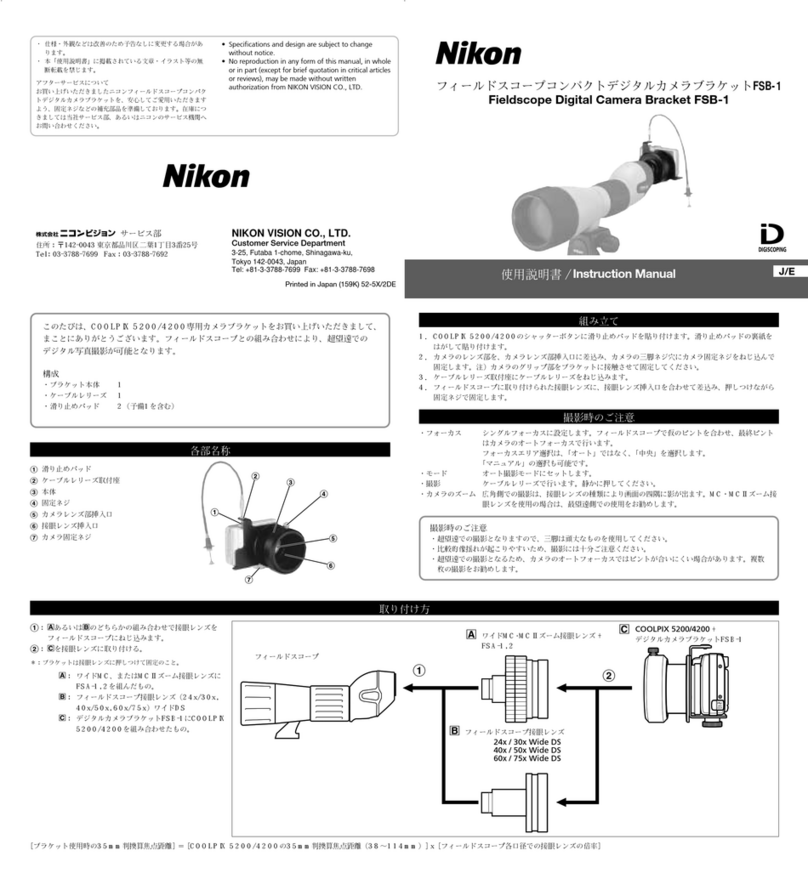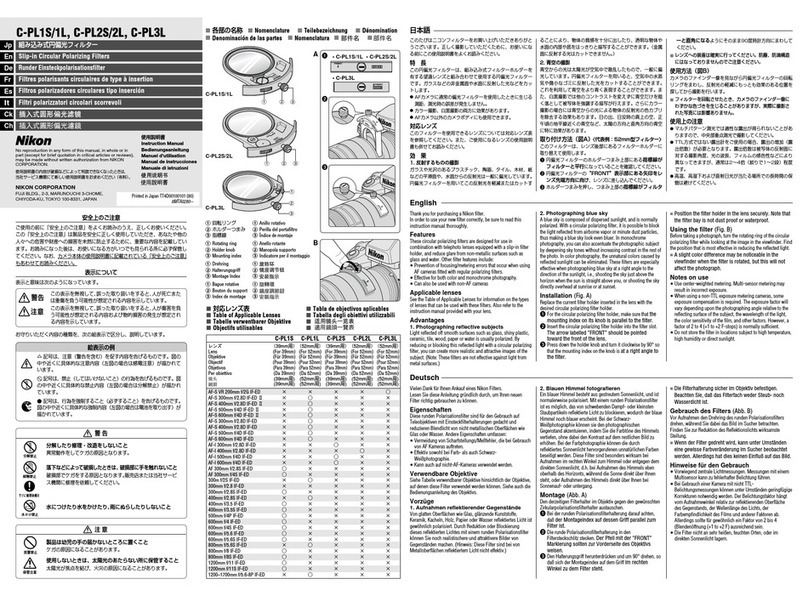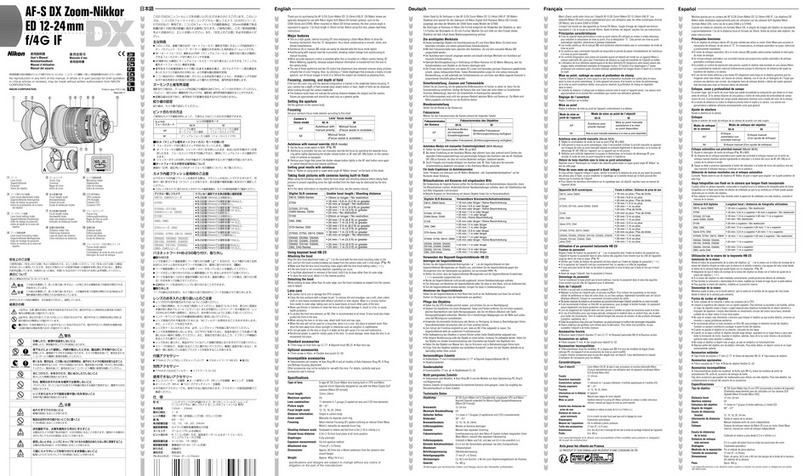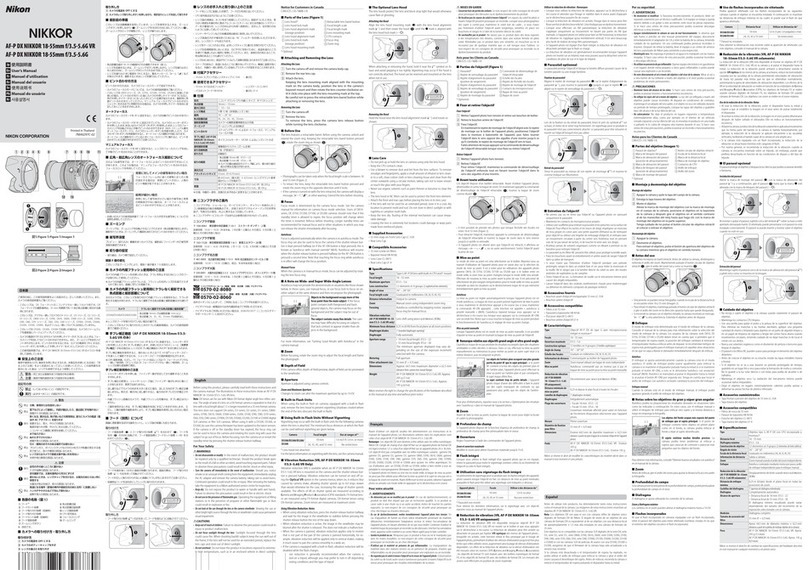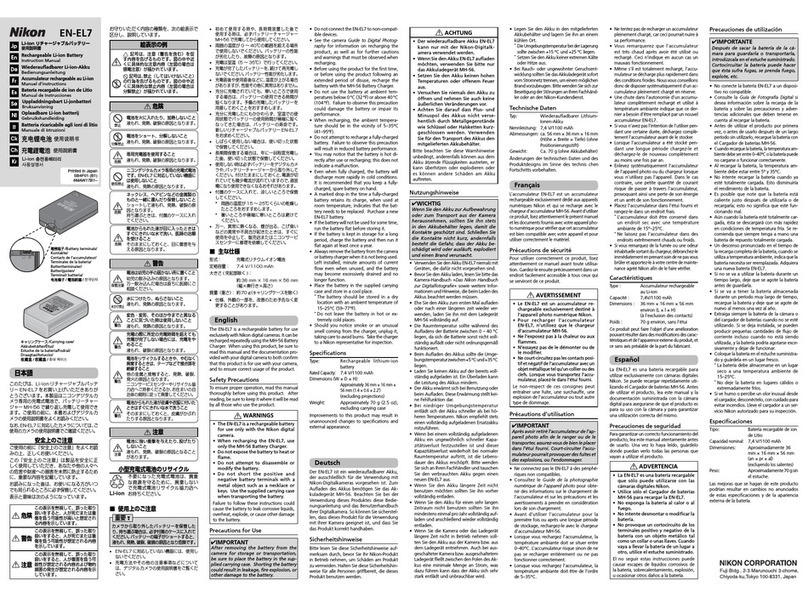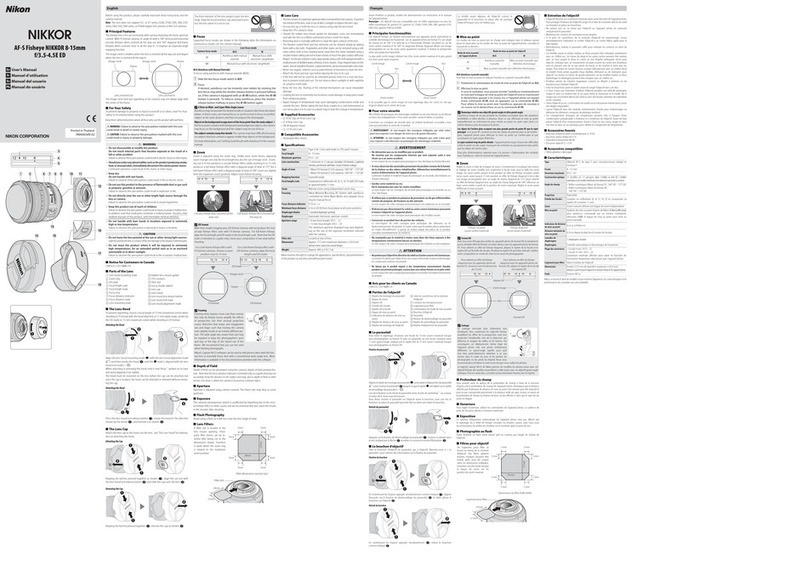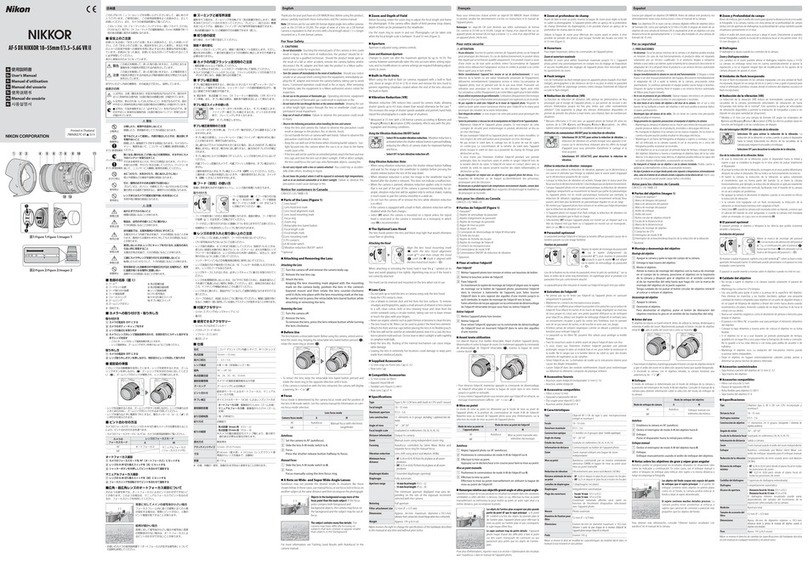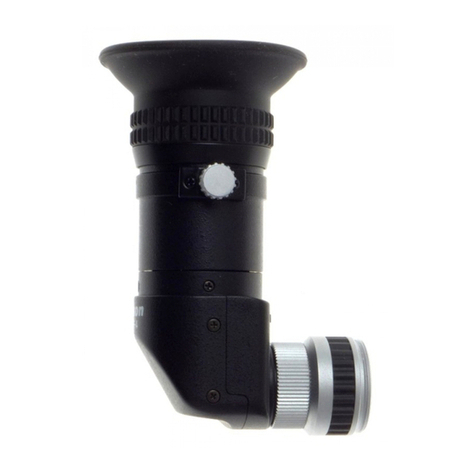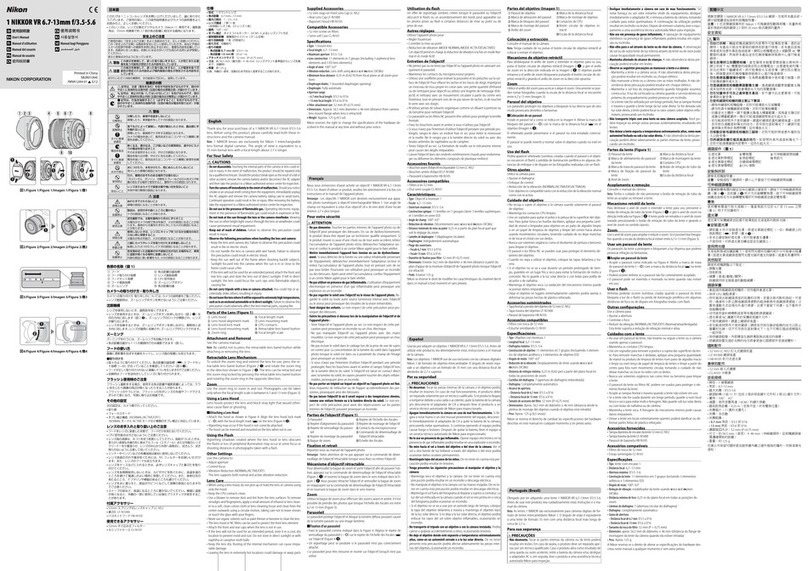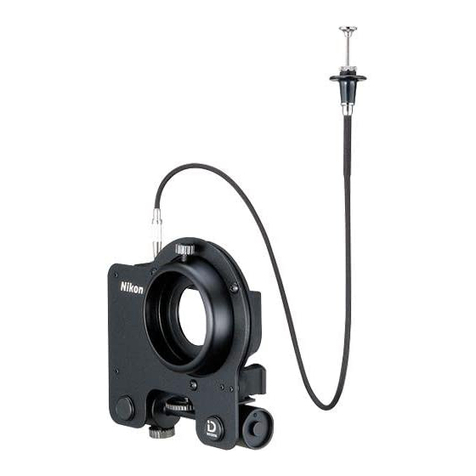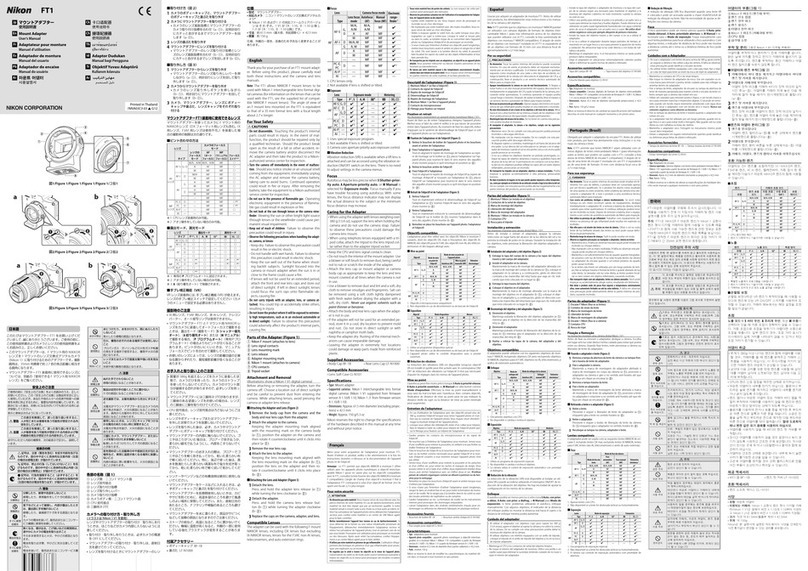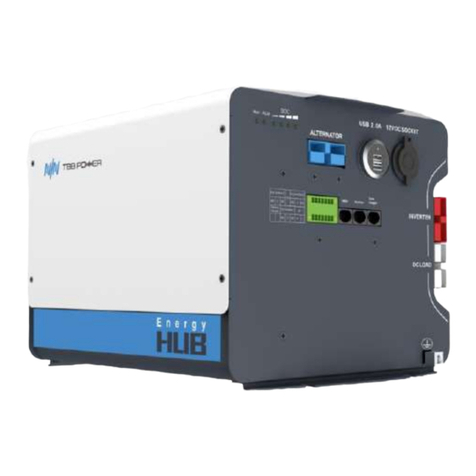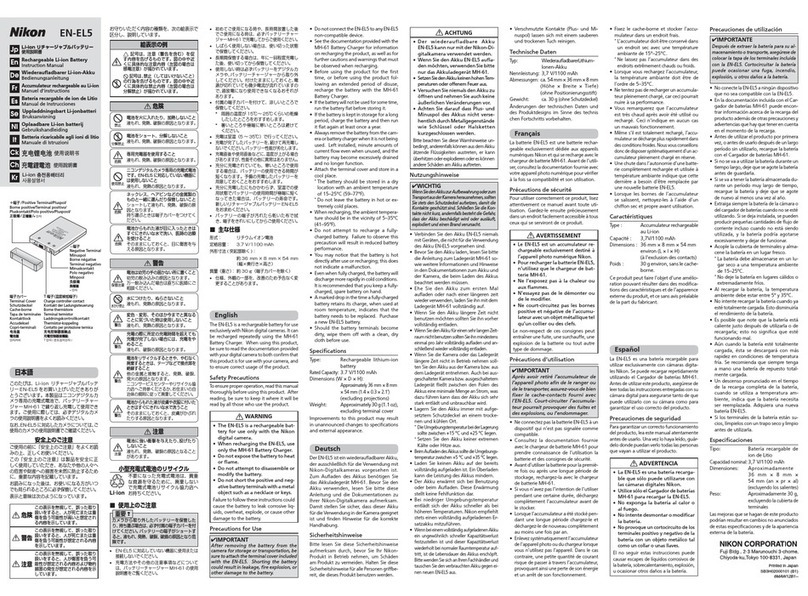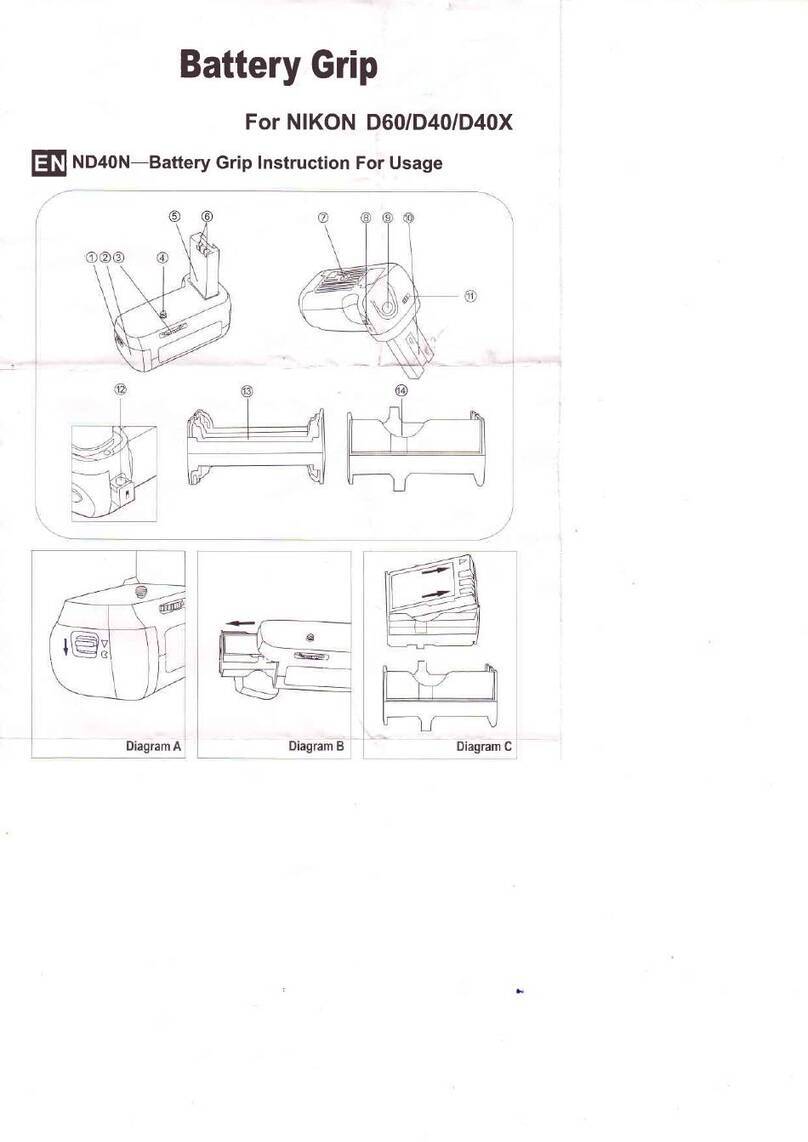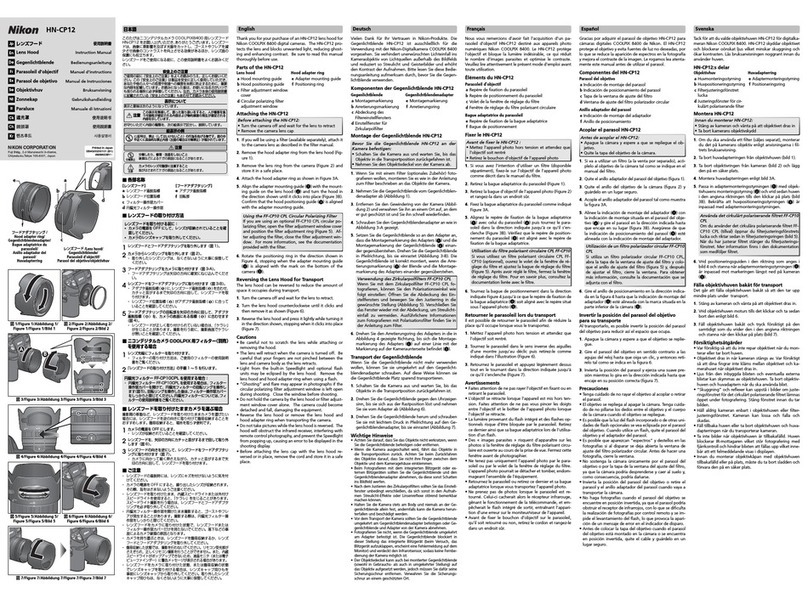
©1995 Nikon Corporation
English
Thank you for your purchase of an AF Nikkor 35mm f/2D lens. Before using this product, please
carefully read both these instructions and the camera manual so you can get the most out of your
lens now and for years to come.
This lens supports autofocus when used with Nikon autofocus cameras (F3AF excluded). It can
also be used for manual focus. Mounted on a compatible camera, it supplies subject distance
information to the camera body.
■
Parts of the Lens
qAperture ring
wMeter coupling ridge
eAperture scale index (white)
rCPU contacts
tAperture-direct-readout scale
yAperture indexing post
uAperture scale
iFocus distance mark
oFocus distance indicator window
!0 lnfrared compensation index (white)
!1 Focus distance indicator
!2 Depth-of-eld indicators
!3 Focus ring
!4 Lens barrel
!5 Minimum aperture lock lever
■
For Your Safety
A
CAUTIONS
• Do not disassemble. Touching the internal parts of the camera or lens could result in injury. In the event of
malfunction, the product should be repaired only by a qualified technician. Should the product break
open as the result of a fall or other accident, remove the camera battery and/or disconnect the AC adapter
and then take the product to a Nikon-authorized service center for inspection.
• Turn the camera o immediately in the event of malfunction. Should you notice smoke or an unusual smell com-
ing from the equipment, immediately unplug the AC adapter and remove the camera battery, taking care
to avoid burns. Continued operation could result in fire or injury. After removing or disconnecting the
power source, take the equipment to a Nikon-authorized service center for inspection.
• Do not use in the presence of ammable gas. Operating electronic equipment in the presence of flammable gas
could result in explosion or fire.
• Do not look at the sun through the lens or the camera viewnder. Viewing the sun or other bright light source
through the lens or viewfinder could cause permanent visual impairment.
• Keep out of reach of children. Particular care should be taken to prevent infants from putting the batteries or
other small parts into their mouths.
• Observe the following precautions when handling the lens and camera:
-Keep the lens and camera dry. Failure to observe this precaution could result in fire or electric shock.
-Do not handle the lens or camera with wet hands. Failure to observe this precaution could result in
electric shock.
-Keep the sun well out of the frame when shooting backlit subjects. Sunlight focused into the camera
when the sun is in or close to the frame could cause a fire.
-If the lens will not be used for an extended period, attach the front and rear lens caps and store the lens
out of direct sunlight. If left in direct sunlight, the lens could focus the sun’s rays onto flammable objects,
causing fire.
■
Important!
• Do not use the lens with PK-1 or PK-11 auto extension rings or with BR-4 or BR-2 auto rings. Failure to ob-
serve this precaution could damage the lens CPU contacts. The PK-11A may be used in place of the PK-11
and the BR-2A in place of the BR-2.
• The lens can not be used with the AF Finder DX-1 for Nikon F3AF cameras.
■
Focusing Screens
The cameras in the “Focusing Screens”table support a variety of focusing screens for use with dif-
ferent lenses or in dierent situations.The screens listed in the table are suited for use with this lens.
When using B2/B3, E2/E3, or K2/K3 screens with cameras not listed in this table, refer respectively
to columns B, E, or K.
Screen
Camera
EC-B/
EC-E
A/L
B
C
D
E
G1
G2
G3
G4
H1
F6
F5+ DP-30
(+0.5)
F5+ DA-30
(+0.5)
(+1.0)
F4+ DP-20
F4+ DA-20
(+1/2)
F3
Screen
Camera
H2
H3
H4
J
K
P
M
R
T
U
F
F6
F5+ DP-30
F5+ DA-30
(+0.5)
F4+ DP-20
F4+ DA-20
F3
: Recommended.
: Vignetting visible in viewfinder (photographs are not affected).
( ): Figures in parentheses give the exposure compensation for center-weighted metering. Select
“Other screen” for Custom Setting b6 (“Screen comp.”) when adjusting exposure compensation
for the F6; note that with screens other than B or E,“Other screen”must be selected even when the
value for exposure compensation is 0. Users of the F5 and F4 can adjust exposure compensation
using Custom Setting 18 or the focusing screen exposure compensation dial, respectively; see the
camera manual for details.
Empty cell: Not suited to use with this lens. Note that type M screens can however be used for photomicrog-
raphy and macro photography at magnifications of 1 : 1 or higher.
■
The Minimum Aperture Lock Lever (Figure A)
The Minimum Aperture Lock Lever (Figure A)
Lock aperture at f/22 when shooting in programmed auto or shutter-priority auto mode.
1Rotate the aperture ring to the minimum aperture setting (f/22).
2Slide the lock lever toward the aperture ring so that the white dot on the lock lever aligns
with the orange dot.
To release the lock, slide the lever in the opposite direction.
■
Lens Care
• Use a blower to remove dust and lint from the lens surfaces. To remove smudges and nger-
prints, apply a small amount of ethanol or lens cleaner to a soft, clean cotton cloth or lens-
cleaning tissue and clean from the center outwards using a circular motion, taking care not to
leave smears or touch the glass with your ngers.
• A lens hood or NC lter can be used to protect the front lens element.
• Attach the front and rear caps when the lens is not in use.
• Keep the lens dry. Rusting of the internal mechanism can cause irreparable damage.
• If the lens will not be used for an extended period, store it in a cool, dry location to prevent mold
and rust. Do not store in direct sunlight or with naphtha or camphor moth balls.
• Leaving the lens in extremely hot locations could damage or warp parts made from reinforced
plastic.
■
Compatible Accessories
• 52 mm screw-on lters
• 52 mm screw-on Lens Hood HN-3
• Flexible Lens Pouch CL-0715
■
Specifications
Focal length 35 mm
Maximum aperture f/2
Lens construction 6 elements in 5 groups
Angle of view 62°
Distance information Output to camera
Focus distance indicator Graduated in meters and feet from 0.25 m (0.9ft) to infinity (∞)
Aperture scale f/2 to f/22 on both standard and aperture-direct-readout scales
Minimum aperture lock Provided
Diaphragm Fully automatic
Metering Maximum aperture metering used with cameras that have CPU couplings
Mount Nikon bayonet mount
Filter-attachment size 52 mm (P = 0.75 mm)
Dimensions Approx. 64.5 mm maximum diameter × 43.5 mm (distance from camera lens
mount ange); overall length is approx. 53 mm
Weight Approx. 205 g (7.2 oz)
Nikon reserves the right to change the specifications of the hardware described in this manual at any time and
without prior notice.
Figure A Minimum aperture lock lever
■
Depth of Field (Metric)
(m)
Focus
distance
Depth of eld
Reproduction
ratio
f/2
f/2.8
f/4
f/5.6
f/8
f/11
f/16
f/22
0.25 0.249 – 0.251 0.249 – 0.251 0.248 – 0.252 0.247 – 0.253 0.246 – 0.254 0.254 – 0.256 0.243 – 0.258 0.240 – 0.262
1/4.23
0.30 0.298 – 0.302 0.297 – 0.303 0.296 – 0.304 0.295 – 0.305 0.293 – 0.308 0.290 – 0.311 0.286 – 0.316 0.281 – 0.323
1/5.68
0.35 0.347 – 0.353 0.346 – 0.354 0.344 – 0.356 0.342 – 0.359 0.399 – 0.363 0.335 – 0.368 0.328 – 0.376 0.321 – 0.388
1/7.10
0.40 0.396 – 0.404 0.394 – 0.406 0.392 – 0.409 0.388 – 0.413 0.383 – 0.419 0.378 – 0.426 0.369 – 0.439 0.358 – 0.457
1/8.52
0.50 0.492 – 0.508 0.489 – 0.511 0.485 – 0.516 0.479 – 0.523 0.471 – 0.534 0.461 – 0.549 0.445 – 0.575 0.428 – 0.611
1/11.32
0.70 0.682 – 0.719 0.676 – 0.726 0.666 – 0.738 0.653 – 0.755 0.635 – 0.782 0.615 – 0.819 0.583 – 0.890 0.550 – 0.996
1/16.91
10.961 – 1.04 0.946 – 1.06 0.925 – 1.09 0.898 – 1.13 0.861 – 1.20 0.819 – 1.30 0.759 – 1.51 0.698 – 1.90
1/25.3
21.83 – 2.20 1.77 – 2.30 1.69 – 2.46 1.59 – 2.71 1.47 – 3.20 1.34 – 4.16 1.17 – 8.50 1.02 – ∞
1/53.1
∞19.5 – ∞ 14.0 – ∞ 9.8 – ∞ 7.0 – ∞ 4.9 – ∞ 3.6 – ∞ 2.5 – ∞ 1.9 – ∞
1/∞
■
Close-up Photography (Metric)
Close-up Photography (Metric)
(cm)
Accessory
Close-up photography
Close-up photography (lens reversed)
Close-up photography (lens reversed)
Reproduction ratio
Subject eld
Focus
distance
Reproduction ratio
Subject eld
Focus distance
No. 0 close-up lens 1/39 – 1/3.8 94.1 × 141 – 9.2 × 13.8 151 – 23.7 – – –
No. 1 close-up lens 1/19– 1/3.5 44.9 × 67.3 – 8.4 × 12.6 77.5 – 22.7 – – –
No. 2 close-up lens 1/9.4 – 1/3.0 22.6 × 33.8 – 7.1 × 10.7 43.9 – 20.9 – – –
No. 1 with No. 2 close-up lens
No. 1 with No. 2 close-up lens 1/6.3 – 1/2.6 15.2 × 22.7 – 6.3 × 9.4 33.2 – 19.9 – – –
PK-Ring
11/4.5 – 1/1.4 10.8 × 16.2 – 1.7 × 2.6 25.9 – 16.5 – – –
PN ring 1.5 – 1.7 1.6 × 2.5 – 1.4 × 2.1 16.6 – 17.1 – – –
PB-4 or PB-5 bellows attachment
PB-4 or PB-5 bellows attachment
21.2 – 5.1 2.0 × 3.0 – 0.47 × 0.70 16.2 – 28.1 2.6 – 6.6 0.91 × 1.4 – 0.37 × 0.55 19.8 – 33.1
PB-6 bellows attachment 1.3 – 5.8 1.8 × 2.7 – 0.42 × 0.62 16.4 – 30.3 2.3 – 5.9 1.03 × 1.54 – 0.41 × 0.61 18.9 – 30.7
PS-4 or PS-5 slide copying adapter
PS-4 or PS-5 slide copying adapter – – – 2.6 – 6.6 0.91 × 1.4 – 0.37 × 0.55 19.8 – 33.1
PS-6 slide copying adapter
PS-6 slide copying adapter – – – 2.3 – 4.7 1.03 × 1.54 – 0.51 × 0.77 18.9 – 26.6
PB-6M macro copy stand 1.3 – 4.8 1.8 × 2.7 – 0.50 × 0.75 16.4 – 26.9 2.3 – 4.8 1.03 × 1.54 – 0.50 × 0.75 18.9 – 26.9
PB-6E extension bellows 1.3 – 12.2 1.8 × 2.7 – 0.2 × 0.3 16.4 – 53.0 2.3 – 12.3 1.03 × 1.54 – 0.20 × 0.29 18.9 – 53.4
PF-2, PF-3, or PF-4 repro copy outt
PF-2, PF-3, or PF-4 repro copy outt
31/21.6– 1/4.2 51.9 × 77.9– 10.2 × 15.2 85.3 – 25.0 – – –
1.First figure is for PK-11A when used alone, remaining figures for rings PK-11A through PK-13, PK-11 through PK-13, or PK-1 through PK-3 used together. Note the
PK-11 and PK-1 can not be attached directly to the lens.
2.The reproduction ratios for the PS-4 and PS-5 slide copying adapters when used with the lens reversed are measured with the BR-3 or ring attached.
3.The figures for the PF-2, PF-3, and PF-4 repro copy outfits are for a subject positioned on the base plate when the lens is used without close-up attachments.
■
Depth of Field (Imperial)
Depth of Field (Imperial)
(ft)
Focus
distance
Depth of eld
Reproduction
ratio
f/2
f/2.8
f/4
f/5.6
f/8
f/11
f/16
f/22
0.9 10 ⁄ in. –
10 ⁄ in.
10 ⁄ in. –
10 ⁄ in.
10 ⁄ in. –
10 ⁄ in.
10 ⁄ in. –
10 ⁄ in.
10 ⁄ in. –
11 in.
10 ⁄ in. –
11 ⁄ in.
10 ⁄ in. –
11 ⁄ in.
10 ⁄ in. –
11 ⁄ in.
1/4.9
111 ⁄ in. –
1 ft ⁄ in.
11 ⁄ in. –
1 ft ⁄ in.
11 ⁄ in. –
1 ft ⁄ in.
11 ⁄ in. –
1 ft ⁄ in.
11 ⁄ in. –
1 ft ⁄ in.
11 ⁄ in. –
1 ft ⁄ in.
11 ⁄ in. –
1 ft ⁄ in.
11 ⁄ in. –
1 ft ⁄ in.
1/5.8
1.25 1 ft 2 ⁄ in. –
1 ft 3 ⁄ in.
1 ft 2 ⁄ in. –
1 ft 3 ⁄ in.
1 ft 2 ⁄ in. –
1 ft 3 ⁄ in.
1 ft 2 ⁄ in. –
1 ft 3 ⁄ in.
1 ft 2 ⁄ in. –
1 ft 3 ⁄ in.
1 ft 2 ⁄ in. –
1 ft 3 ⁄ in.
1 ft 1 ⁄ in. –
1 ft 4 ⁄ in.
1 ft 1 ⁄ in. –
1 ft 4 ⁄ in.
1/8.0
1.5 1 ft 5 ⁄ in. –
1 ft 6 ⁄ in.
1 ft 5 ⁄ in. –
1 ft 6 ⁄ in.
1 ft 5 ⁄ in. –
1 ft 6 ⁄ in.
1 ft 5 ⁄ in. –
1 ft 6 ⁄ in.
1 ft 5 ⁄ in. –
1 ft 7 in.
1 ft 4 ⁄ in. –
1 ft 7 ⁄ in.
1 ft 4 ⁄ in.–
1 ft 8 ⁄ in.
1 ft 3 ⁄ in. –
1 ft 9 ⁄ in.
1/10.1
21 ft 11 ⁄ in. –
2 ft 8 ⁄ in.
1 ft 11 ⁄ in. –
2 ft ⁄ in.
1 ft 11 in. –
2 ft 1 ⁄ in.
1 ft 10 ⁄ in. –
2 ft 1 ⁄ in.
1 ft 10 ⁄ in. –
2 ft 2 ⁄ in.
1 ft 9 ⁄ in. –
2 ft 3 ⁄ in.
1 ft 8 ⁄ in. –
2 ft 5 ⁄ in.
1 ft 7 ⁄ in. –
2 ft 7 ⁄ in.
1/14.4
32 ft 10 ⁄ in. –
3 ft 1 ⁄ in.
2 ft 10 ⁄ in. –
3 ft 1 ⁄ in.
2 ft 9 ⁄ in. –
3 ft 2 ⁄ in.
2 ft 8 ⁄ in. –
3 ft 4 ⁄ in.
2 ft 7 ⁄ in. –
3 ft 6 ⁄ in.
2 ft 6 ⁄ in. –
3 ft 9 ⁄ in.
2 ft 4 in. –
4 ft 9 ⁄ in.
2 ft 1 ⁄ in. –
4 ft 2 ⁄ in.
1/22.9
54 ft 8 ⁄ in. –
5 ft 4 ⁄ in.
4 ft 6 ⁄ in. –
5 ft 6 ⁄ in.
4 ft 4 ⁄ in. –
5 ft 9 ⁄ in.
4 ft 2 ⁄ in. –
6 ft 2 ⁄ in.
3 ft 11 ⁄ in. –
6 ft 10 ⁄ in.
3 ft 7 ⁄ in. –
6 ft 1 ⁄ in.
3 ft 3 ⁄ in. –
11 ft 4 ⁄ in.
2 ft 11 in. –
23 ft ⁄ in.
1/39.8
15 12 ft 3 in. –
19 ft 4 in.
11 ft 5 in. –
21 ft 11 in.
10 ft 4 in. –
27 ft 4 in.
9 ft 3 in. –
41 ft 2 in.
7 ft 11 in. –
174 ft 5 in. 6 ft 9 in. – ∞ 5 ft 5 in. – ∞ 4 ft 5 in. – ∞
1/124.5
∞64 ft – ∞ 45 ft 10 in. – ∞ 32 ft 2 in. – ∞ 23 ft – ∞ 16 ft 2 in. – ∞ 11 ft 10 in. – ∞ 8 ft 3 in. – ∞ 6 ft 1 in. – ∞
1/∞
■
Close-up Photography (Imperial)
Close-up Photography (Imperial)
(in.)
Accessory
Close-up photography
Close-up photography (lens reversed)
Close-up photography (lens reversed)
Reproduction
ratio
Subject eld
Focus
distance
Reproduction
ratio
Subject eld
Focus distance
No. 0 close-up lens 1/39 – 1/3.8 37.0 × 55.5 – 3.6 × 5.4 59.4 – 9.3 – – –
No. 1 close-up lens 1/19– 1/3.5 17.7 × 26.5 – 3.3 × 5.0 30.5 – 8.9 – – –
No. 2 close-up lens 1/9.4 – 1/3.0 8.9 × 13.3 – 2.8 × 4.2 17.3 – 8.2 – – –
No. 1 with No. 2 close-up lens
No. 1 with No. 2 close-up lens 1/6.3 – 1/2.6 6.0 × 8.9 – 2.5 × 3.7 13.1 – 7.8 – – –
PK-Ring
11/4.5 – 1/1.4 4.3 × 6.4 – 0.69 × 1.0 10.2 – 6.5 – – –
PN ring 1.5 – 1.7 0.65 × 0.97 – 0.56 × 0.84 6.6 – 6.8 – – –
PB-4 or PB-5 bellows attachment
PB-4 or PB-5 bellows attachment
21.2 – 5.1 0.79 × 1.2 – 0.18 × 0.28 6.4 – 11.1 2.6 – 6.6 0.36 × 0.54 – 0.14 × 0.22 7.8 – 13.0
PB-6 bellows attachment 1.3 – 5.8 0.71 × 1.06 – 0.16 × 0.25 6.5 – 12.0 2.3 – 5.9 0.40 × 0.61 – 0.16 × 0.24 7.4 – 12.1
PS-4 or PS-5 slide copying adapter
PS-4 or PS-5 slide copying adapter – – – 2.6 – 6.6 0.36 × 0.54 – 0.14 × 0.22 7.8 – 13.0
PS-6 slide copying adapter
PS-6 slide copying adapter – – – 2.3 – 4.7 0.40 × 0.61 – 0.20 × 0.30 7.4 – 10.5
PB-6M macro copy stand 1.3 – 4.8 0.71 × 1.06 – 0.20 × 0.30 6.5 – 10.6 2.3 – 4.8 0.40 × 0.61 – 0.20 × 0.30 7.4 – 10.6
PB-6E extension bellows 1.3 – 12.2 0.71 × 1.06 – 0.08 × 0.12 6.5 – 20.9 2.3 – 12.3 0.40 × 0.61 – 0.08 × 0.12 7.4 – 21.0
PF-2, PF-3, or PF-4 repro copy outt
PF-2, PF-3, or PF-4 repro copy outt
31/21.6– 1/4.2 20.4 × 30.7– 4.0 × 6.0 33.6 – 9.8 – – –
1.First figure is for PK-11A when used alone, remaining figures for rings PK-11A through PK-13, PK-11 through PK-13, or PK-1 through PK-3 used together. Note the
PK-11 and PK-1 can not be attached directly to the lens.
2.The reproduction ratios for the PS-4 and PS-5 slide copying adapters when used with the lens reversed are measured with the BR-3 or ring attached.
3.The figures for the PF-2, PF-3, and PF-4 repro copy outfits are for a subject positioned on the base plate when the lens is used without close-up attachments.


